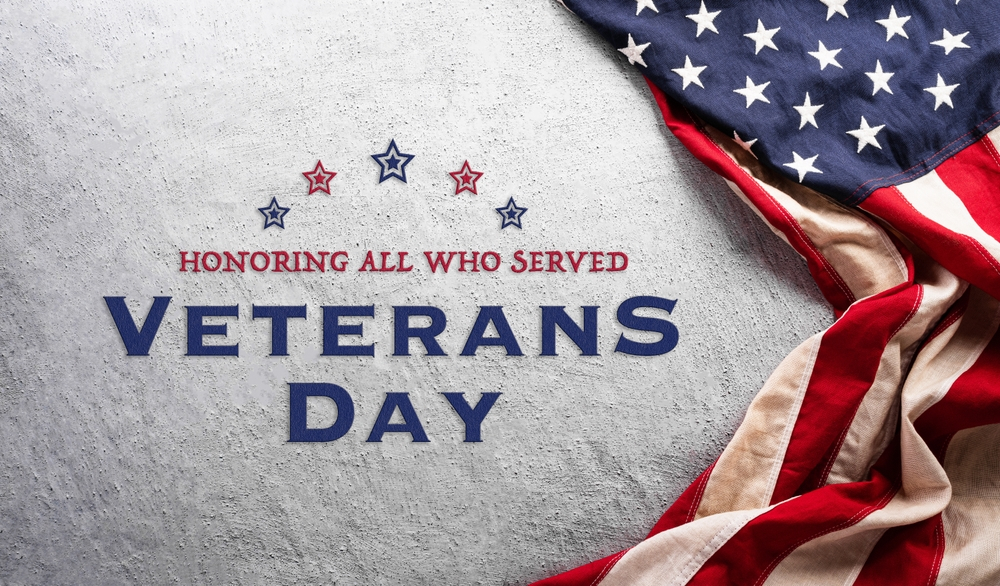Top 10 Facts About Veterans Day to Honor Our Heroes

Veterans Day, observed annually on November 11th, is a profound and significant holiday dedicated to honoring the brave men and women who have served in the United States Armed Forces.
This day is an opportunity to recognize and appreciate the sacrifices made by veterans to protect our freedom and ensure the safety of our nation. Originating in the aftermath of World War I, Veterans Day has evolved to commemorate veterans from all wars and conflicts.
The importance of honoring our veterans extends beyond a single day; it is a year-round reminder of the debt of gratitude we owe to those who have defended our country.
By understanding the history and traditions associated with Veterans Day, we can better appreciate the invaluable contributions of our heroes and inspire future generations to uphold their legacy.
1. The History of Veterans Day
The origins of Veterans Day can be traced back to the end of World War I, a conflict that reached its conclusion on November 11, 1918, at the eleventh hour of the eleventh day of the eleventh month. This momentous occasion marked the cessation of hostilities between the Allied nations and Germany and led to the establishment of Armistice Day by President Woodrow Wilson in 1919.
Armistice Day was initially dedicated to honoring the veterans of World War I and to celebrating the triumph of peace. However, following the experiences of World War II and the Korean War, there was a growing recognition of the need to acknowledge the contributions of veterans from all conflicts.
Consequently, in 1954, President Dwight D. Eisenhower signed legislation that officially transformed Armistice Day into Veterans Day, a national holiday to honor American veterans of all wars.
This pivotal change underscored the ongoing commitment to recognizing the sacrifices and achievements of veterans who have served valiantly throughout the nation’s history.
2. Difference Between Veterans Day and Memorial Day
While both Veterans Day and Memorial Day honor the brave individuals who have served in the United States Armed Forces, they commemorate distinct aspects of military service.
Veterans Day, observed annually on November 11th, is dedicated to celebrating all veterans, both past and present, who have served honorably in the military. It is a day to express gratitude for their service and to acknowledge their contributions to national security.
On the other hand, Memorial Day, observed on the last Monday of May, specifically honors those who have died while serving in the military. This solemn day is marked by commemorative ceremonies, moments of silence, and the decoration of graves in memory of the fallen.
Both holidays hold immense importance; Veterans Day celebrates the service and sacrifices of all military personnel, fostering a sense of national pride and unity, while Memorial Day serves as a poignant reminder of the ultimate sacrifice made by soldiers to protect and defend the nation’s freedoms.
Understanding the distinctions between these two holidays allows us to appropriately honor the legacy and contributions of the military community.
3. Armistice Day Transition
The transition from Armistice Day to Veterans Day reflects a broader recognition of the valiant efforts of military personnel across all American wars, beyond just the First World War.
Originally established by President Woodrow Wilson in November 1919 as Armistice Day to commemorate the end of World War I, it was a day dedicated to promoting peace and honoring the veterans of that specific conflict.
However, in the wake of World War II and the Korean War, the United States saw the need to recognize veterans of all wars. Thus, in 1954, under President Dwight D. Eisenhower’s administration, Congress passed legislation to change the holiday’s name from Armistice Day to Veterans Day.
This legislative change, enshrined by the Veterans Day National Act, underscored a shift in focus from a single historical event to a more inclusive celebration that honors all American veterans. The transition signifies a broader commitment to recognizing the service and sacrifices of all military personnel who have served the nation.
4. The Date Significance
The choice of November 11th for Veterans Day is deeply rooted in historical context, specifically linked to the conclusion of World War I. On November 11, 1918, the Allied forces and Germany signed an armistice, marking the end of hostilities on the Western Front.
This armistice went into effect at the eleventh hour of the eleventh day of the eleventh month, signifying a pivotal moment of peace after four years of relentless conflict.
The following year, President Woodrow Wilson proclaimed November 11th as Armistice Day, a day dedicated to honoring the veterans of World War I and celebrating the triumph of peace.
The significance of this date was further solidified when Congress passed a resolution in 1926, calling for annual observances. By 1938, November 11th had become a legal holiday in the United States, initially known as Armistice Day. However, after the widespread participation of American soldiers in World War II and the Korean War, the holiday’s scope expanded. In 1954, President Dwight D.
Eisenhower signed a bill renaming Armistice Day to Veterans Day, thereby broadening the holiday to honor American veterans of all wars.
This historical context underscores the importance of maintaining November 11th as a day to celebrate and honor the brave men and women who have served in the United States Armed Forces, reflecting not just the end of a significant war but also a continued commitment to recognizing the valor of all veterans.
5. Global Commemorations
Veterans Day in the United States is part of a broader tradition of honoring military service and sacrifice around the world. Many countries have their own versions of this holiday, often observed on or around November 11th, to mark the armistice ending World War I.
For instance, in Commonwealth countries, Remembrance Day is held on November 11th and is marked by ceremonies, wreath-laying, and a moment of silence at 11 AM to remember the fallen soldiers of both World Wars and subsequent conflicts.
Similarly, in France and Belgium, Armistice Day (Jour de l’Armistice) is a significant national holiday with parades, church services, and public gatherings to commemorate those who served and sacrificed. While the name and specific customs may vary, the underlying sentiment of gratitude and remembrance is a common thread that unites these international observances.
Comparatively, Veterans Day in the United States not only commemorates the end of World War I but also honors all American veterans, making it distinct in its more inclusive recognition of military service across all conflicts.
6. Veterans Day Traditions
Veterans Day is marked by a rich tapestry of customs and ceremonies that collectively honour the service and sacrifice of military personnel. One of the most prevalent traditions involves parades, where veterans, military units, and community organisations march proudly through city streets, often accompanied by bands playing patriotic music.
These parades serve as a public display of gratitude and recognition, fostering community spirit and national pride. Another common practice is the laying of wreaths at memorials and cemeteries, a solemn ceremony that pays homage to the fallen.
In many communities, this tradition is carried out by veterans’ groups, schoolchildren, scouts, and civic leaders, often culminating in moments of silence to reflect on the sacrifices made by soldiers.
Additionally, various other practices such as flag-raising ceremonies, speeches by public officials, and the organisation of veterans’ reunions and appreciation events help to strengthen the bonds between the military and civilian populations.
Schools and educational institutions also play a part by holding special assemblies or programs that teach students about the significance of Veterans Day and the history of military service in the United States. These traditions, whether grand or modest, ensure that the contributions of veterans are remembered and celebrated across the nation.
7. Famous Veteran Speeches
Throughout the years, Veterans Day has been marked by powerful speeches from prominent figures, offering heartfelt gratitude and reflection on the sacrifices made by military personnel. Notable speeches have included those delivered by U.S. Presidents and military leaders, who have used their platform to honor veterans and inspire the nation.
For instance, President Ronald Reagan’s speech at Arlington National Cemetery in 1985 stands out for its poignant message, emphasizing the undying duty to remember those who served. “Most of all, we remember the devotion and gallantry with which all of them ennobled their nation as they became champions of a noble cause.”
Similarly, President Barack Obama’s addresses often highlighted themes of unity and perseverance, such as in 2009, when he stated, “America’s commitment to its veterans is binding; it’s a sacred trust that endures throughout the generations.”
These speeches not only commemorate the bravery and dedication of veterans but also serve as a call to action, urging the nation to continue supporting its troops and their families. Through eloquent words and profound messages, these addresses have cemented the legacy of Veterans Day as a solemn and significant observance.
8. Veterans Day in Education
Educational institutions across the United States play a vital role in honoring Veterans Day by instilling a sense of appreciation and respect for military service among students. Schools often hold special assemblies where veterans are invited to share their experiences and stories, providing students with a personal and profound connection to the day’s significance.
These assemblies frequently feature patriotic performances by student bands and choirs, enhancing the sense of occasion.
Moreover, many schools engage students in various activities such as writing letters or creating art projects dedicated to veterans, fostering a deeper understanding of their sacrifices. History lessons may be supplemented with discussions about the importance of Veterans Day, encouraging students to reflect on the values of bravery, service, and patriotism.
By integrating these programs and activities into the curriculum, schools help to ensure that the legacy of Veterans Day is passed on to future generations, promoting a culture of gratitude and acknowledgment for those who have served in the armed forces.
9. Veterans Day Controversies
While Veterans Day is a time for honoring military service, it has not been without its controversies. Debates often arise over the observation and practices associated with the holiday. Some argue that the increasing commercialization of Veterans Day, similar to what has happened with Memorial Day, detracts from its solemn purpose of honoring veterans.
Sales events and retail promotions sometimes overshadow the day’s intended significance, leading to calls for a reevaluation of how the holiday is observed.
Historically, there have also been disagreements about the date of the holiday. After transitioning from Armistice Day to Veterans Day in 1954 to encompass all veterans, not just those of World War I, the date was temporarily moved to October in the 1970s as part of the Uniform Monday Holiday Act, before public outcry restored it to November 11th.
In modern times, controversies also extend to the inclusivity and recognition of all veterans, particularly addressing the issues faced by minority veterans and those who served in less-recognized arenas.
These ongoing debates reflect a broader tension between maintaining traditional values and adapting practices to contemporary sensibilities, underscoring the complex nature of how society honors military service.
10. Ways to Honor Veterans Year-Round
Honoring veterans shouldn’t be confined to just one day a year; there are numerous practical ways to support and honor veterans year-round. Volunteering is an impactful method, such as offering your time at VA hospitals or veteran support centers where many vets seek assistance.
Monetary donations to reputable veteran organizations can also provide critical resources for mental health services, job training, and housing.
Another meaningful approach is community involvement, including organizing or participating in local events that celebrate veterans and their achievements, such as charity runs, commemorative ceremonies, or community clean-ups in the name of veterans.
Being an active participant in supporting veterans can also mean employing veterans, advocating for their needs, or simply taking the time to listen to their stories and showing appreciation for their service.
Through these actions, you can contribute to a culture of respect and gratitude that truly honors the sacrifices made by the military personnel in your community.
Conclusion
Veterans Day stands as a solemn reminder of the valor and dedication exhibited by the men and women who have served in the U.S. military. As we’ve explored the top 10 facts about Veterans Day, we’ve delved into its rich history, revered traditions, and the powerful speeches that shape its meaning.
We’ve examined the role of educational institutions in fostering respect for veterans and highlighted various ways communities can honor these brave individuals.
As we conclude, it is essential to recognize the profound significance of Veterans Day as more than just a date on the calendar. It is a call to action for all of us to continually honor and respect those who have served.
Whether it’s through community volunteering, supporting veteran-focused organizations, or simply extending a heartfelt “thank you,” every gesture contributes to a culture of gratitude.
Let’s make it a collective mission to ensure that the sacrifices made by our veterans are acknowledged and celebrated every day, not just on November 11th. By doing so, we pay true homage to the heroes who have given so much for our freedom.




